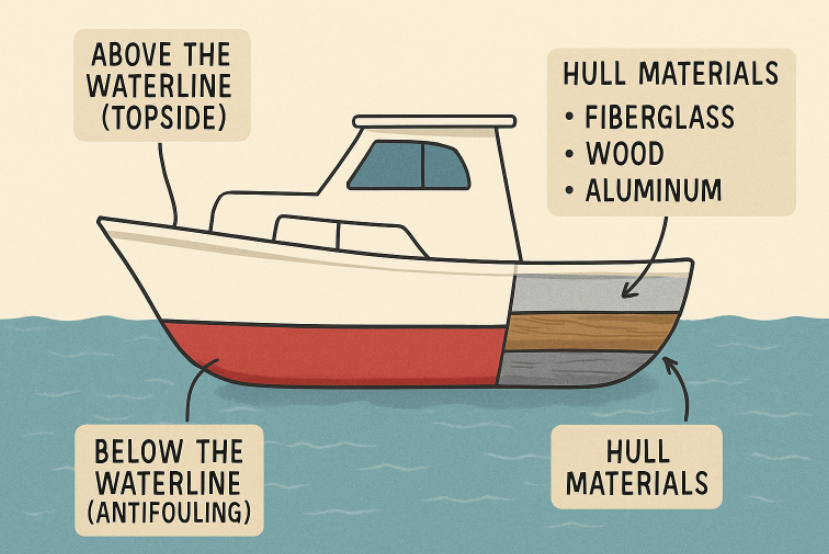Selecting the right marine paint is crucial for protecting your boat against harsh water conditions and maintaining its aesthetic appeal. The right paint system not only enhances your vessel’s look but also adds years of functional life. Whether you’re a seasoned boater or preparing for your first refit, understanding the details will pay off in both performance and appearance. For optimal results, ensure you start with reliable marine paint supplies before beginning your project. Many boat owners underestimate the importance of compatibility between surface materials, environmental demands, and paint chemistry. With so many products available, taking the time to learn about each option will help you protect your investment and avoid costly mistakes. This guide provides step-by-step details to help you choose the optimal marine paint, prepare your boat properly, and maintain it in top condition for the seasons ahead. From hull material to climate challenges, the proper knowledge is your first defense against corrosion, growth, and weathering.
Table of Contents
Understanding Boat Materials
The construction material of your boat significantly determines both the type and performance of marine paints. Fiberglass, wood, and aluminum are the most common materials, and each comes with its own set of challenges. Fiberglass hulls typically benefit from epoxy-based coatings due to their superior adhesion and durability. Wooden boats, on the other hand, require paints that allow breathability to prevent trapped moisture, which could lead to decay or rot. If your vessel is made of aluminum, specialized paints are necessary to combat corrosion and ensure strong bonding. Synthetic or abrasive paints may cause pitting and rapid degradation if improperly chosen.
Types of Marine Paint
Marine paints are not one-size-fits-all. Each section of your boat—above and below the waterline—faces unique stresses. Knowing which paint serves what part can help you maximize durability and efficiency.
- Antifouling Paint: The portion of your hull beneath the waterline is susceptible to barnacles, algae, and other marine organisms. Antifouling paints release biocides slowly to prevent marine growth, thus reducing drag and improving fuel efficiency. This is especially crucial if your boat spends a considerable amount of time in the water, whether docked or moored. For more information on antifouling paints, refer to this Wikipedia article.
- Topside Paint: These paints are specifically designed for surfaces above the waterline, where intense sunlight and weather exposure are prevalent. Topside coatings, particularly two-part polyurethanes, provide superior UV resistance and gloss retention, ensuring a long-lasting color.
- Primer: A high-quality primer is essential regardless of hull material. Primers anchor the final coats, even out minor imperfections, and serve as a protective intermediary layer.
Considering Environmental Factors
The location and intensity of your boating activity play a crucial role in selecting the right paint. Saltwater, with its higher corrosion potential, demands tougher coatings and frequent reapplications of antifouling paint to prevent barnacle colonies and salt-induced decay. In freshwater, while corrosion is less severe, algae and plant fouling is more typical and should be handled with paints designed accordingly.
Climate matters too. Boats exposed to intense sun and tropical heat benefit from UV-resistant topside paints that don’t yellow or peel with prolonged exposure. In colder climates, flexibility and resistance to cracking during freeze-thaw cycles become paramount. Matching the paint to your localized conditions shields both your hull and your wallet from premature failures.
Surface Preparation and Application
Even the highest quality marine paint will underperform if the surface isn’t adequately prepared. Cleanliness is essential: all oils, residues, and old, loose coatings must be removed entirely. Sanding not only smooths out rough areas but also promotes mechanical adhesion for your primer and paint. For aluminum and metal hulls, mechanical etching or specialized surface treatments may be required for optimal bonding.
Once prepped, application technique makes all the difference. Always follow the manufacturer’s instructions on mixing, application (rolling, brushing, or spraying), and drying times. Apply multiple coats as recommended, allowing for proper curing between layers. Thorough preparation and proper layering guarantee a finish that not only looks professional but endures the elements.
Maintenance and Repainting
Preserving your boat’s finish doesn’t stop once the paint dries. Regular inspection and simple preventive care make a notable difference. Check painted surfaces throughout the season for signs of peeling, fading, and marine buildup. Washing your boat with fresh water post-use is one of the simplest ways to remove salt and grime before they cause damage. Follow a repainting schedule in alignment with your boat type and local environment. Antifouling paints may need annual touch-ups, especially if you operate in saltwater. Topside paints might last up to five years with proper care, while primers and undercoats should constantly be refreshed as needed before a new topcoat is applied.
Common Mistakes to Avoid
Several avoidable issues regularly undermine otherwise solid paint jobs. Inadequate surface prep is a leading cause of early paint failure. Always take the time to thoroughly clean, sand, and prime. Choosing the wrong paint type—especially one with mixed materials or improper environmental suitability—can cause a range of issues, from poor adhesion to dangerous corrosion or rot. Another frequent error is painting in the wrong weather conditions. High humidity, rain, or extreme temperatures can all affect curing and finish quality. Planning your painting project during mild, dry spells will help you achieve a smoother, longer-lasting result.
Conclusion
Choosing the ideal marine paint involves understanding your boat’s hull material, your local environment, and the proper sequence of prep and application. Investing time in learning these details ensures that your boat is not only protected against the elements but also retains its appearance and value for the long haul. Diligent surface prep, proper paint selection, and consistent maintenance create not just a beautiful finish, but a resilient one—season after season.










